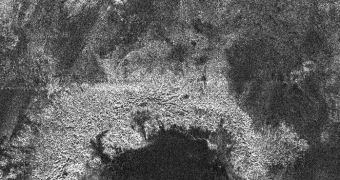The Saturnine moon Titan elicited the interest of astronomers several years ago, when the first images of its surface revealed interesting features, in addition to a thick atmosphere. Since 2004, the NASA Cassini spacecraft has been in orbit around the gas giant, and the probe carried out numerous flybys of the natural satellite in the mean time. Over the past 6 years, more than 22 percent of Titan's surface has been surveyed, and experts identified about 49 craters total. They are now using the data to gain more insight into the moon's history, Space reports.
“Impact craters are created on every planet because of asteroids, comets and other debris that collide with their surfaces. Analyzing impact craters is a standard technique to tell you the history of the world,” says the lead author of the new study, expert Charles Wood. He holds an appointment as a senior scientist at the Tucson, Arizona-based Planetary Science Institute. Details of the Cassini studies, carried out using the high-resolution Radar Mapper instrument, are published in the latest issue of the esteemed scientific publication Icarus.
One of the reasons why experts are so interested in this celestial object is the fact that it resembles the early Earth very closely. More precisely, its atmosphere most likely looks like our own did shortly after the planet formed. Even if Titan now has temperatures of about minus 290 degrees Fahrenheit (minus 179 degrees Celsius), some believe it may still fulfill conditions for the existence of life. Though water is hard as granite at these temperatures, liquid hydrocarbons laden the moon's north and south poles, concentrated in lakes. “Titan is really remarkable because it is such an Earth-like planet,” Wood says.
“Some people say Titan is like a cold version of early Earth. If it were warmer, you'd definitely think life existed there,” the expert adds, saying that understanding the conditions on the moon, as well as the way they evolve, could result in gaining a clearer picture of how life appeared on our own planet from similar circumstances. But carrying out such studies is notoriously difficult, on account of the thick layer of gases that cover the surface of the object. Its presence makes it impossible for the cameras on Cassini to see the surface directly, and so only radars can be used to survey it.
Investigating craters offers a new tool of investigating what happened on Titan recently. In addition to meteorites and other space impactors, the formations could also be a byproduct of volcanism, which would indicate an active interior on the moon. “When you see a round (structure) in a new world, you have to think there are two likely origins: impact cratering or volcanism,” Wood says. He adds that, if the entire surface of Titan is covered in impact craters, then this could be a clear indicator that volcanism does not exist on the rock. But with only 22 percent of the moon's surface covered by radar data, it's still too early to say which is the case, he adds.

 14 DAY TRIAL //
14 DAY TRIAL //